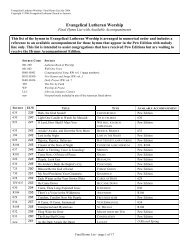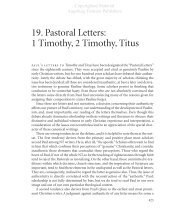Chapter 1 - Augsburg Fortress
Chapter 1 - Augsburg Fortress
Chapter 1 - Augsburg Fortress
Create successful ePaper yourself
Turn your PDF publications into a flip-book with our unique Google optimized e-Paper software.
16 | Eros and the Christ<br />
than authoritative guide, has largely gone unobserved in the modern period.<br />
Accordingly, his letters have been conceptualized as instruments of admonition,<br />
teaching, and self-defense. There are, however, exceptions to this emphasis<br />
on apostolic authority among scholars today. Stanley Stowers called attention<br />
to 1:7-8 as a possible example of the motif of yearning for the loved one, a<br />
commonplace that he correctly observed could be easily documented in letters<br />
of friendship. 16 Some years later, he summarized the work of a number of<br />
classicists on ancient epistolography and brought their findings to bear on<br />
Philippians: “Expressions of affection and longing to be with one’s friends<br />
were considered appropriate for letters of friendship and manifest themselves in<br />
commonplace phraseology and topoi.” 17 The significance of Stowers’s insight<br />
grows when placed in its historical context. In the early 1990s a challenge arose<br />
to a widely held view that Paul organized the letter of Philippians around the<br />
problem of his authority; friendship, according to a number of scholars, was<br />
instead both the letter’s topic and the point of its composition. 18 The letter was<br />
not simply an instrument of control but a means of preserving and intensifying<br />
the shared lives of separated friends. Paul wrote in the language of friendship to<br />
increase friendship. 19 Yet, while the categorization of Philippians as a letter of<br />
friendship is, I believe, a real advance because it both recognizes philophronetic<br />
motifs and paints a less authoritarian picture of Paul, it nevertheless accepts as<br />
unproblematic the notion of the letter as a bearer of the writer’s presence. So,<br />
while affirming Philippians as a friendly letter, I want to challenge the idea that<br />
letters delivered presence purely and simply.<br />
Letters are indeed substitutes for the writer’s physical presence, but even in<br />
that moment when they create an illusion of presence they also remind readers<br />
of the author’s absence. Letters of friendship simultaneously give comfort and<br />
refresh the wounds of separation, and this double effect was even more the case<br />
when letter writers enhanced friendly feelings with allusions to erōs and pothos.<br />
Greek letters, beginning in the fourth century, provide numerous examples<br />
of eroticized friendship. John Chrysostom, for example, charged his letters<br />
with erotic terminology, often characterizing himself as a lover (ἐραστής) both<br />
vehement (σφοδρός) and warm (θερμός). 20 In Chrysostom’s letters friends are<br />
connected by bonds of love and longing. 21 Erotic love furthermore explains the<br />
insatiate desire that he and the recipients of his letters have for more and longer<br />
epistles. 22 In Philippians, Paul anticipates the epistolary habits of the fourth<br />
century and pushes past the limits of friendship into erōs by telling his own story<br />
and Jesus’ in terms of longing desire, but in so doing he problematized the very<br />
presence and voice his letter created.




